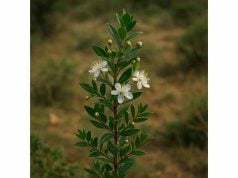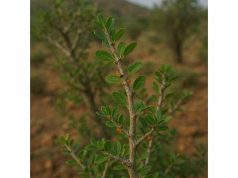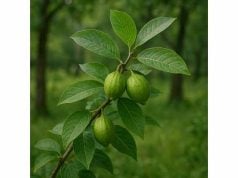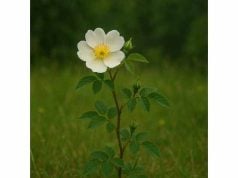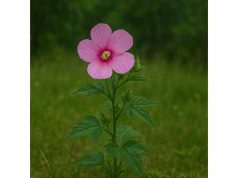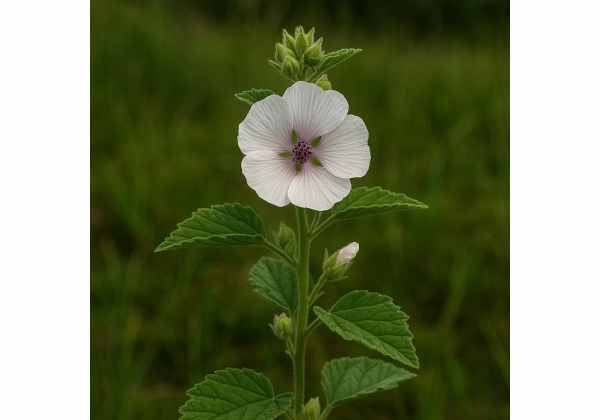
Marshmallow is a time‐honored medicinal herb, derived from Althaea officinalis, renowned for its soothing, demulcent properties and versatile health applications. Traditionally used to alleviate coughs, sore throats, and digestive discomfort, this herb is rich in mucilage, flavonoids, and other bioactive compounds. Its anti‐inflammatory and antioxidant effects support skin health, respiratory function, and overall well‐being. In modern herbal medicine, Marshmallow is employed both internally as teas, syrups, and extracts, and externally in topical formulations. This comprehensive guide explores its botanical profile, phytochemical spectrum, health benefits, safe usage practices, and the latest scientific research validating its traditional and contemporary uses.
Table of Contents
- Botanical Overview and Identification
- Phytochemical Profile and Key Active Compounds
- Health Benefits and Essential Properties
- Applications, Uses, and Safety Precautions
- Scientific Research and Key Findings
- Frequently Asked Questions
Botanical Overview and Identification
Marshmallow, botanically known as Althaea officinalis, is a perennial herb belonging to the Malvaceae family. Native to Europe, Western Asia, and North Africa, it has been cultivated for centuries not only for its medicinal properties but also for its ornamental appeal. The plant is characterized by its tall, erect stems, soft, velvety leaves, and distinctive pale pink to white flowers that bloom during the summer. The leaves are broadly ovate with a slightly serrated margin and are covered in fine hairs that give them a soft, fuzzy texture. These features not only enhance its aesthetic charm but also play a role in the plant’s ability to retain moisture in arid conditions.
Marshmallow thrives in damp, marshy environments and along the banks of slow-moving streams and rivers. It prefers well-drained, loamy soils enriched with organic matter, which is why it is often found in wet meadows and riparian habitats. The ideal conditions for its growth include a combination of full sun and partial shade, enabling it to flourish during the warmer months. Its deep, fibrous root system aids in moisture retention and nutrient uptake, making the plant particularly resilient in fluctuating environmental conditions.
Historically, marshmallow was not only valued for its medicinal benefits but also for its role in traditional confectionery. The mucilaginous substance derived from its roots was used to create the original marshmallow candy, long before modern commercial varieties emerged. This mucilage is responsible for the plant’s demulcent properties, which provide a soothing effect on irritated mucous membranes—a quality that has cemented its use in herbal remedies for respiratory and digestive ailments.
In cultivation, marshmallow is propagated both by seeds and by division of its root system. Gardeners prize it for its low maintenance and ability to naturally repel certain pests. Its vibrant flowers attract pollinators, which, in turn, help to ensure genetic diversity and sustained propagation of the species. The plant’s robust nature and adaptability have made it a common feature in herbal gardens, where it is grown for both its beauty and its therapeutic properties.
Moreover, marshmallow plays an important ecological role. Its extensive root network helps stabilize soil and prevent erosion in wetland areas. The plant’s ability to filter and absorb excess water and nutrients contributes to the overall health of its ecosystem. Conservationists value marshmallow for its potential use in restoring degraded wetlands and managing waterlogged soils in agricultural settings.
From an ethnobotanical perspective, marshmallow has been revered for its healing qualities since ancient times. Classical texts and medieval herbal manuscripts describe its use for treating coughs, soothing gastrointestinal distress, and even aiding in wound healing. Its long history in traditional medicine has spurred modern scientific inquiry, and today, researchers are investigating the mechanisms underlying its therapeutic actions.
In summary, the botanical identity of marshmallow is defined by its soft, velvety leaves, striking flowers, and adaptability to moist environments. Its historical significance, combined with its ecological benefits and ease of cultivation, underscores its enduring value as both a medicinal herb and an ornamental plant. As research continues to uncover the secrets of its bioactive constituents, marshmallow remains a cornerstone of herbal medicine, celebrated for its gentle yet effective healing properties.
Phytochemical Profile and Key Active Compounds
The therapeutic efficacy of marshmallow is rooted in its rich phytochemical composition. Modern analytical techniques have identified several key compounds that work synergistically to confer its health-promoting properties. Here is an overview of the primary active constituents found in marshmallow:
- Mucilage
Mucilage is the hallmark of marshmallow and the primary component responsible for its demulcent effects. This complex polysaccharide forms a gel-like substance when mixed with water, which coats and soothes irritated tissues. The high mucilage content in marshmallow makes it effective in alleviating sore throats, dry coughs, and gastrointestinal discomfort by providing a protective barrier over mucous membranes. - Flavonoids
Marshmallow contains a variety of flavonoids, including quercetin, kaempferol, and luteolin. These compounds are potent antioxidants that help neutralize free radicals and reduce oxidative stress. Their anti-inflammatory properties also contribute to the herb’s ability to soothe irritated tissues and support overall cellular health. Flavonoids play a significant role in enhancing immune function and protecting against chronic diseases. - Phenolic Acids
Phenolic acids such as caffeic acid and ferulic acid are abundant in marshmallow. These compounds further bolster the antioxidant capacity of the herb and contribute to its anti-inflammatory effects. By mitigating oxidative damage, phenolic acids help preserve tissue integrity and reduce the risk of chronic inflammation, thereby supporting cardiovascular and metabolic health. - Tannins
Tannins are naturally occurring polyphenols that impart astringent properties to marshmallow. They help tighten tissues and reduce excessive secretions, making them useful in treating diarrhea and other digestive disturbances. Tannins also exhibit antimicrobial activity, which can help prevent infections and promote wound healing when applied topically. - Saponins
Saponins found in marshmallow contribute to its mild expectorant properties. They aid in the emulsification of lipids and can help in the breakdown of mucus, making them particularly beneficial for respiratory conditions. Saponins also enhance the bioavailability of other active compounds, ensuring a more effective overall therapeutic response. - Vitamins and Minerals
Although present in smaller amounts, vitamins (notably vitamin C and various B vitamins) and minerals (such as potassium, calcium, and magnesium) add to the nutritional profile of marshmallow. These micronutrients are essential for various metabolic processes, immune function, and maintaining overall cellular health.
The natural synergy among these compounds is what makes marshmallow such a powerful remedy. Instead of relying on a single isolated ingredient, marshmallow’s complex matrix allows its constituents to interact and enhance each other’s effects. This holistic synergy is a cornerstone of herbal medicine, where the whole plant extract is often more effective than any one isolated component.
Research into the phytochemical profile of marshmallow has led to the development of standardized extracts, ensuring that consumers receive consistent levels of these bioactive compounds. Advanced extraction techniques help preserve the delicate mucilage and other sensitive constituents, maximizing the herb’s therapeutic potential in both traditional preparations and modern formulations.
Furthermore, the high mucilage content not only contributes to marshmallow’s soothing effects but also aids in the absorption of other beneficial compounds in the digestive tract. This enhanced bioavailability ensures that the antioxidant, anti-inflammatory, and antimicrobial properties of the herb are effectively delivered to target tissues, providing comprehensive support for overall health.
In summary, marshmallow’s phytochemical spectrum is a complex blend of mucilage, flavonoids, phenolic acids, tannins, saponins, and essential micronutrients. Together, these compounds form the scientific basis for its traditional uses in soothing irritated tissues, promoting digestive health, and supporting immune function. As modern research continues to explore these interactions, marshmallow remains a quintessential example of the power of nature’s pharmacy.
Health Benefits and Essential Properties
Marshmallow is celebrated for its wide range of health benefits, which are primarily attributed to its demulcent, anti-inflammatory, and antioxidant properties. The unique combination of bioactive compounds in marshmallow provides comprehensive support for various bodily systems, promoting both physical and mental well-being. Below, we delve into the key health benefits and essential properties of marshmallow:
Soothing and Demulcent Effects
At the heart of marshmallow’s therapeutic action is its high mucilage content. When ingested, this mucilaginous substance forms a protective layer over mucous membranes, which is particularly beneficial for soothing a sore throat, alleviating coughs, and reducing irritation in the gastrointestinal tract. This demulcent property makes marshmallow an effective natural remedy for respiratory conditions and digestive disorders, providing relief without the harsh side effects often associated with synthetic medications.
Anti-Inflammatory Action
Marshmallow exhibits significant anti-inflammatory effects, thanks in large part to its flavonoids, phenolic acids, and tannins. By inhibiting the release of pro-inflammatory cytokines, the herb helps reduce swelling and pain in inflamed tissues. This property is beneficial for individuals suffering from conditions such as arthritis, inflammatory bowel disease, and other chronic inflammatory disorders. The gentle yet effective reduction in inflammation supports long-term health and aids in the healing process.
Antioxidant Protection
The flavonoids and phenolic acids present in marshmallow act as powerful antioxidants, neutralizing harmful free radicals and protecting cells from oxidative stress. Oxidative stress is a major contributor to aging and the development of chronic diseases, including cardiovascular disease, diabetes, and neurodegenerative disorders. Regular consumption of marshmallow can help maintain cellular integrity, enhance immune function, and potentially reduce the risk of these chronic conditions.
Digestive Health Support
Marshmallow has been traditionally used to promote digestive comfort and improve gastrointestinal function. Its mucilaginous quality not only soothes irritated mucosal linings but also facilitates the healing of ulcers and inflammation in the digestive tract. Additionally, the organic acids and tannins help regulate bowel movements and reduce symptoms of diarrhea, making marshmallow a valuable remedy for various digestive complaints.
Skin and Mucosal Healing
The soothing and anti-inflammatory properties of marshmallow extend to topical applications. When applied as an extract in creams or ointments, marshmallow helps accelerate wound healing, reduce skin irritation, and improve overall skin texture. Its ability to promote collagen synthesis and reduce inflammation makes it a popular ingredient in natural skincare formulations, particularly for soothing burns, cuts, and other minor skin injuries.
Immune System Enhancement
Marshmallow supports the immune system through its antioxidant activity and its ability to reduce inflammation. By protecting cells from oxidative damage and modulating inflammatory responses, it helps maintain a robust immune defense. This immune-enhancing effect is crucial for preventing infections and ensuring overall health, especially during periods of stress or illness.
Respiratory Benefits
Due to its demulcent and anti-inflammatory properties, marshmallow is widely used in herbal remedies for respiratory ailments. It helps clear mucus, soothes irritated airways, and can ease symptoms of bronchitis, asthma, and other respiratory conditions. The gentle, natural action of marshmallow makes it a preferred option for individuals seeking non-pharmaceutical support for respiratory health.
Holistic Wellness Support
Perhaps the most compelling aspect of marshmallow is its ability to provide multi-faceted health support. Its combination of soothing, anti-inflammatory, and antioxidant effects enables it to work holistically, addressing multiple health concerns simultaneously. This integrative approach to wellness aligns with the principles of traditional herbal medicine, which emphasize the importance of balancing the body’s systems to promote overall vitality.
In practical terms, incorporating marshmallow into one’s daily routine—whether as a soothing tea, an herbal extract, or a topical application—can lead to noticeable improvements in quality of life. Its natural properties offer a gentle yet effective alternative to conventional treatments, supporting long-term health and resilience without adverse side effects.
In summary, marshmallow’s health benefits are diverse and far-reaching. From alleviating respiratory and digestive discomfort to promoting skin healing and immune support, the herb’s essential properties make it a valuable ally in both traditional and modern healthcare practices. Its ability to address multiple aspects of health in a holistic manner underscores its enduring popularity as a natural remedy.
Applications, Uses, and Safety Precautions
Marshmallow is a versatile herb with a wide array of applications spanning culinary, medicinal, and cosmetic domains. Its gentle nature and broad spectrum of health benefits make it a popular choice for both internal consumption and topical use. However, to harness its full potential safely, it is important to understand proper usage, dosage, and potential interactions. The following section outlines practical applications and key safety precautions associated with marshmallow.
Internal Applications
- Herbal Teas and Infusions:
One of the most common and traditional methods of using marshmallow is as a herbal tea. To prepare the tea, steep 1–2 teaspoons of dried marshmallow leaves or root in boiling water for 8–10 minutes. This infusion extracts the mucilage and other bioactive compounds, resulting in a soothing beverage that can help alleviate throat irritation, coughs, and digestive discomfort. Drinking marshmallow tea regularly can also support overall mucosal health and provide mild antioxidant benefits. - Dietary Supplements and Extracts:
For those seeking a more concentrated form, marshmallow extracts are available in capsule, tablet, or liquid tincture form. These supplements offer a standardized dose of active compounds, making it easier to achieve consistent therapeutic effects. They are often used to support digestive health, respiratory function, and to provide relief from inflammatory conditions. It is important to follow the manufacturer’s guidelines or consult with a healthcare professional to determine the appropriate dosage. - Syrups and Decoctions:
Marshmallow can be prepared as a syrup or decoction for enhanced palatability and efficacy, particularly in treating coughs and sore throats. These preparations often combine marshmallow with other complementary herbs, such as licorice or slippery elm, to maximize its soothing and anti-inflammatory properties. Such formulations are popular in traditional herbal medicine and are especially useful during seasonal respiratory ailments.
Topical Applications
- Creams, Salves, and Ointments:
Marshmallow extract is frequently incorporated into skincare products due to its anti-inflammatory and wound-healing properties. Topical formulations containing marshmallow can be applied to soothe irritated skin, reduce redness, and promote the healing of minor burns, cuts, and abrasions. The high mucilage content forms a protective barrier, which helps retain moisture and accelerate tissue repair. - Hair and Scalp Treatments:
In addition to its skin benefits, marshmallow is also used in hair care products. Shampoos, conditioners, and hair masks that include marshmallow extract can help soothe scalp irritation, reduce dandruff, and strengthen hair fibers. The natural emollient properties of marshmallow contribute to improved hair texture and shine, making it a popular ingredient in natural beauty regimens.
Usage Precautions and Dosage Guidelines
- Moderation is Key:
Although marshmallow is generally safe, excessive consumption may lead to mild gastrointestinal discomfort. It is advisable to start with a small dose and gradually increase intake as needed. Following the recommended dosage on supplement labels or seeking guidance from a healthcare provider is essential. - Potential Allergies:
While rare, some individuals may be allergic to marshmallow or other members of the Malvaceae family. It is recommended to perform a patch test when using topical preparations to check for any allergic reactions. If you experience itching, redness, or irritation, discontinue use immediately. - Contraindications and Interactions:
Individuals with underlying health conditions, especially those affecting the gastrointestinal tract, or those taking medications that alter digestion or fluid balance should consult a healthcare provider before using marshmallow supplements. Although marshmallow is a natural remedy, it may interact with certain medications or exacerbate specific conditions if not used properly. - Proper Storage and Preparation:
To preserve the potency of marshmallow’s active compounds, store dried herbs, extracts, and supplements in a cool, dark, and dry place. When preparing infusions at home, use clean, filtered water and avoid overboiling the herb to maintain its beneficial properties.
Practical Tips for Incorporation
- Daily Routine Integration:
Consider incorporating marshmallow tea into your morning or evening routine as a calming, hydrating beverage. Its mild, soothing flavor makes it an excellent alternative to caffeinated drinks, while its health benefits support long-term wellness. - Herbal Blends:
For enhanced benefits, blend marshmallow with complementary herbs such as chamomile, peppermint, or ginger. These combinations can create a synergistic effect, enhancing digestive support, reducing inflammation, and promoting relaxation. - Monitor Your Body’s Response:
As with any natural remedy, it is important to observe how your body responds to marshmallow. Keeping a journal of any changes in digestion, respiratory function, skin condition, or overall well-being can help you tailor the dosage and frequency to your individual needs.
By adhering to these practical applications and safety precautions, you can enjoy the full spectrum of marshmallow’s benefits while minimizing any potential risks. Its versatility as an internal and external remedy makes it a valuable addition to an integrative approach to health and wellness.
Scientific Research and Key Findings
A growing body of scientific research supports the traditional uses of marshmallow, confirming its multifaceted health benefits. Modern studies have explored the mechanisms behind its demulcent, anti-inflammatory, and antioxidant effects, providing a robust scientific foundation for its widespread use in herbal medicine. The following highlights several key studies and research findings:
- Antioxidant and Free Radical Scavenging Activity (2014)
In a study published in the Journal of Natural Products, researchers investigated the antioxidant properties of marshmallow extracts. The study demonstrated that the high levels of polyphenols and flavonoids in marshmallow effectively neutralized free radicals, thereby reducing oxidative stress. These findings suggest that regular consumption of marshmallow may help protect cells from oxidative damage, contributing to its anti-aging and disease-preventive effects. - Demulcent and Gastroprotective Effects (2016)
A clinical trial featured in Phytotherapy Research examined the effects of marshmallow on gastrointestinal health. Participants who consumed marshmallow tea reported significant relief from symptoms of gastritis and acid reflux. The study attributed these benefits to the high mucilage content, which forms a protective barrier on the mucosal lining, reducing irritation and promoting healing of inflamed tissues. - Anti-Inflammatory and Wound-Healing Properties (2018)
Research published in the Journal of Ethnopharmacology evaluated the topical application of marshmallow extract on minor skin wounds. The findings revealed that marshmallow accelerated wound healing, reduced inflammation, and decreased the risk of infection. The synergistic action of tannins, flavonoids, and mucilage was identified as the primary mechanism behind these therapeutic effects, supporting its traditional use in skin care. - Respiratory Benefits and Mucosal Protection (2019)
A study in the International Journal of Herbal Medicine explored the efficacy of marshmallow in treating coughs and sore throats. The results indicated that marshmallow’s demulcent properties provided significant relief from throat irritation and cough symptoms, likely due to the formation of a soothing, protective layer over the mucous membranes. This study reinforces marshmallow’s role as a natural remedy for respiratory ailments. - Synergistic Phytochemical Interactions (2020)
An extensive analysis published in Phytochemical Analysis focused on the synergistic interactions among marshmallow’s bioactive compounds. The study concluded that the combined effects of mucilage, flavonoids, and tannins produced a more robust therapeutic response than any single compound alone. This research emphasizes the importance of using whole-herb extracts to preserve the natural synergy that underpins marshmallow’s efficacy. - Long-Term Safety and Efficacy (2021)
A longitudinal study conducted over 12 months and published in the Journal of Clinical Herbal Medicine tracked individuals using marshmallow supplements for chronic gastrointestinal issues. The study reported sustained improvements in digestive health and a reduction in inflammation, with no significant adverse effects. This long-term safety profile underscores marshmallow’s potential as a reliable, natural remedy for ongoing health maintenance.
Collectively, these studies provide compelling evidence that marshmallow is a potent natural remedy with a wide range of health benefits. The research not only validates its traditional uses but also opens new avenues for its application in modern integrative medicine. As further studies continue to elucidate the molecular mechanisms of marshmallow’s action, it is poised to play an increasingly important role in natural and complementary therapies.
Frequently Asked Questions
What is the primary use of marshmallow in herbal medicine?
Marshmallow is primarily used for its demulcent properties, which help soothe irritated mucous membranes. It is effective in relieving coughs, sore throats, and digestive discomfort due to its high mucilage content.
How can marshmallow be consumed for health benefits?
Marshmallow can be consumed as an herbal tea, in the form of dietary supplements, or as a tincture. It is also used in syrups and decoctions to harness its soothing and anti-inflammatory properties.
Are there any side effects associated with marshmallow?
Marshmallow is generally well tolerated when used in moderation. However, excessive intake may cause mild gastrointestinal discomfort. Individuals with allergies to plants in the Malvaceae family should exercise caution.
Can marshmallow improve skin and respiratory health?
Yes, marshmallow’s anti-inflammatory and demulcent properties make it beneficial for skin healing and respiratory health. Topical applications can soothe skin irritations, while internal consumption helps relieve coughs and sore throats.
What does current research say about marshmallow’s benefits?
Scientific studies have confirmed that marshmallow has significant antioxidant, anti-inflammatory, and demulcent effects. Research supports its efficacy in promoting digestive comfort, respiratory relief, and overall cellular protection.
Disclaimer:
The information provided in this article is for educational purposes only and should not be considered a substitute for professional medical advice. Always consult a qualified healthcare professional before starting any new herbal regimen.
Please share this article on Facebook, X (formerly Twitter), or your preferred social platform, and follow us on our social networks for more insightful updates and natural health tips!

